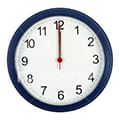Extra Second Added to 2008
by Daniel Menjívar • #news #scienceI came across this interesting article at Reuters about an extra second being added to 2008…

Apparently, there was an international agreement in 1970 which established two time scales. One was based on Earth’s rotation and the other on highly accurate atomic clocks. The extra second is needed to keep the two systems within a second of each other, since Earth’s rotation is gradually slowing.
Here’s an excerpt:
Tick tock … tick: Extra second added to 2008
…
The world’s official timekeepers have added a "leap second" to the last day of the year on Wednesday, to help match clocks to the Earth’s slowing spin on its axis, which takes place at ever-changing rates affected by tides and other factors.
The U.S. Naval Observatory, keeper of the Pentagon’s master clock, said it would add the extra second on Wednesday in coordination with the world’s atomic clocks at 23 hours, 59 minutes and 59 seconds Coordinated Universal Time, or UTC.
…
UTC is the time scale kept by highly precise atomic clocks around the world, accurate to about a billionth of a second per day, the Naval Observatory says. For those with a need for precision timing, it has replaced Greenwich Mean Time, or GMT.
The decision to add or remove a second is the responsibility of the International Earth Rotation and Reference Systems Service, based on its monitoring of the Earth’s rotation.
The goal is to make sure clocks vary from the Earth’s rotational time by no more than 0.9 seconds before an adjustment. That keeps UTC in sync with the position of the sun above the Earth.
Mechanisms such as the Internet-based Network Time Protocol and the satellite-based Global Positioning System depend on precision timing.
The first leap second was introduced into UTC on . The last was added on .
…
Among the reasons for Earth’s slowing whirl on its axis are the braking action of tides, snow or the lack of it at the polar ice caps, solar wind, space dust and magnetic storms, according to the U.S. Commerce Department’s National Institute of Standards and Technology, another timekeeper.
By contrast, a leap day, February 29, occurs once every four years because a complete turn around the sun -- our year with all its seasons -- takes about 365 days and six hours.
In 1970, an international agreement established two time scales: one based on the Earth’s rotation and another on highly accurate atomic clocks.
The U.S. Naval Observatory’s master clock is based on a system that now includes 50 atomic clocks, 36 based on the element cesium and 14 known as hydrogen masers.
With the Earth’s rotation gradually slowing, the periodic insertion of a leap second into the atomic time scale is needed to keep the two systems within a second of each other.
So for us here in Calgary (MST), it means the extra second will be added at around 5pm. It would be cooler if it was just before midnight, but it still means 2008 will be one second longer…
Update –
Here’s an additional excerpt from an article at CBCnews.ca that I thought was interesting:
…
Though the time shift is so nominal it’s not even noticeable, accumulated over a millennium it would mean that noon, generally accepted as the time when the sun is highest in the sky, would actually occur at 1 p.m.
If seconds continued to be added over time, however, the sun would be days behind the human calendar within tens of thousands of years.
That prospect is a cause for worry for some.
"I think [our descendants] will curse us less if we choose to keep the clock reading near 12 p.m. when the sun is highest in the sky," said Steve Allen, an analyst at the University of California at Santa Cruz’s Lick Observatory.
…
Interesting. It will take 1000 years to shift noon to 1pm if the seconds aren’t added, or 10000+ years for the sun to be days behind our current calendar if they are… Hopefully by then, we’ll have a different system for timekeeping, and maybe even a different calendar? I guess we’ll never know…